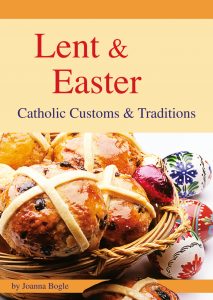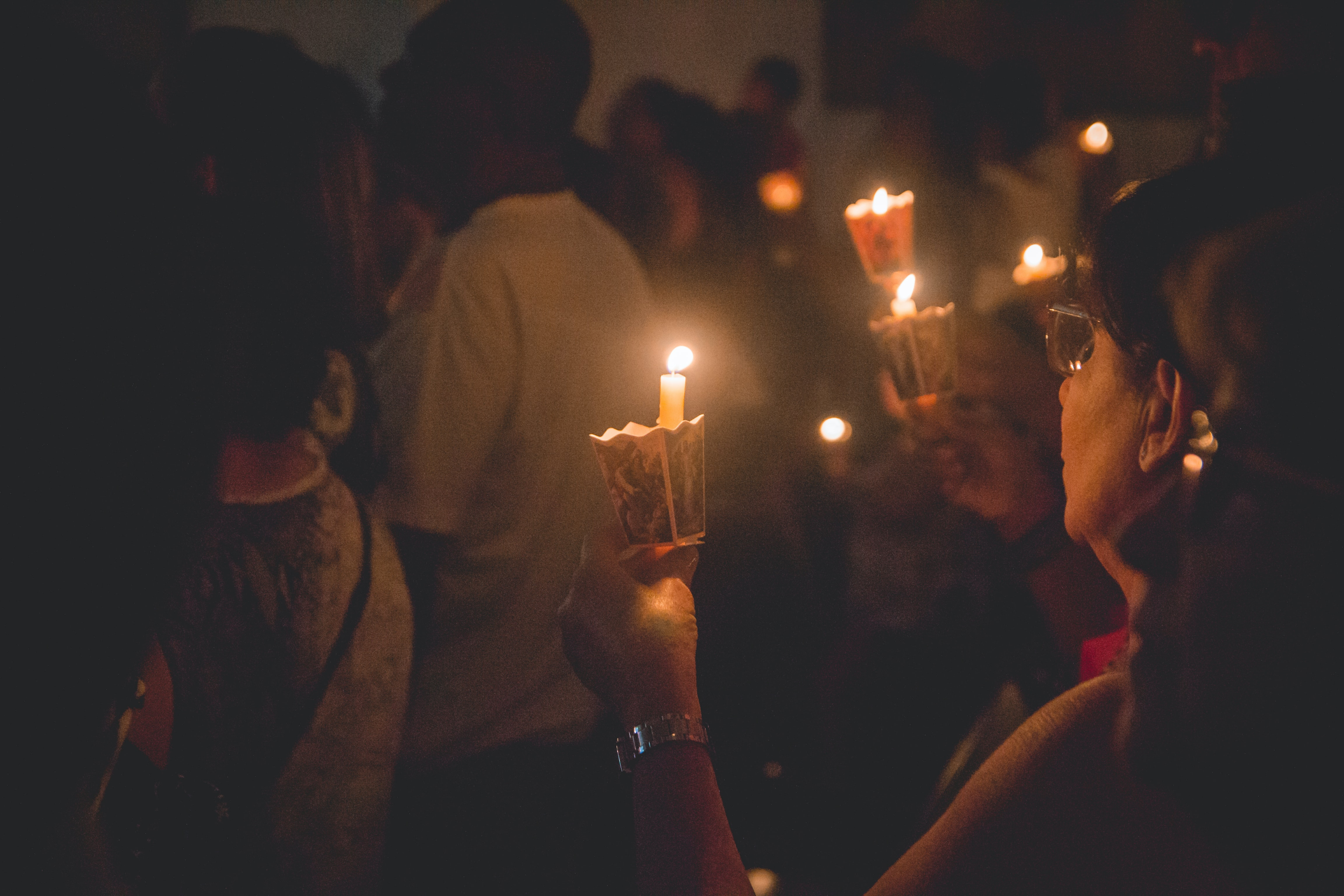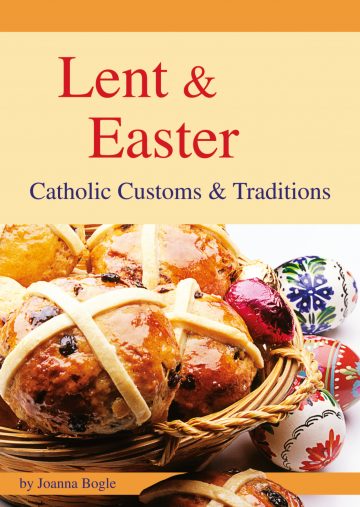On Holy Saturday the Church honours Christ in the tomb. Everything is silent: the Mass is not celebrated, the church is empty. There is an air of expectation. We have celebrated Good Friday, now it is Holy Saturday, and the next day is the third day. And as we recall in the Creed, “On the third day he rose again”.
Preparations
Holy Saturday will for most people be a day of preparation for Easter Sunday. There is a lot to do: there will be a special Easter lunch and probably a gathering of friends and family. There will be Easter eggs and perhaps small Easter gifts.
Easter Eggs – Holy Saturday activities
The reason for Easter eggs, as has been explained, is that as a result of the fasting during Lent there were a great many eggs left over by the time Easter arrived. These were decorated and used in lots of different ways.
It is possible to decorate eggs by first blowing out the contents, by making a small hole at the end of each egg and then blowing through the contents into a bowl. The eggs can then be decorated with stickers, or painted. Attaching a small piece of cotton or ribbon with sticky tape will then enable the decorated eggs to be hung on an Easter branch, a centrepiece for the lunch or breakfast table.
(What to do with the contents of the blown eggs? Well, if you aren’t fussy, you can just use them for scrambled eggs! Or – an old beauty-hint! – adding a raw egg to shampoo is said to be excellent for bringing a shine to the hair and making it healthy).
It is also possible to dye hard-boiled eggs in their shells. You can buy small pellets of dye mixture along with Easterstickers. Using natural dyes is also possible and it is fun to experiment: boiling up eggs with nettles will produce a shell with a dull green colour; onion skins will produce an orange shade, beetroot a soft pink. Rubbing the eggs afterwards gently with a little olive oil will give them a nice shine.
A Polish tradition is to take a decorated basket of eggs and other Easter breakfast foods to be blessed by the priest during Holy Saturday.
Making small baskets or boxes to hold Easter eggs can be a good Holy Saturday activity too: you can make a small basket for miniature eggs by cutting off the bottom half of an empty washing-up liquid bottle. Metal polish will take off the lettering. Mark off straight lines from the top down to the base, about a quarter of an inch apart, and then cut down these. Weave a narrow ribbon in and out to create a basket, and secure it at the top. Add a ribbon handle, and line the basket with crumpled tissue-paper, ready to be filled with small chocolate eggs on Easter morning.
The Easter Vigil
As the evening of Holy Saturday approaches, the Church prepares to celebrate the Resurrection. People gather at church as darkness falls. The Easter Vigil is one of the most dramatic events of the Church’s year. The liturgy of Easter is the summit of the whole of the Church’s liturgy. This is the night of all nights, the most glorious of all feasts, the central point on which the whole of our Faith is centred – it is the reason why we celebrate every Sunday in the year and will do until the end of time, it celebrates the most magnificent event of all history, the Resurrection of Jesus Christ from the dead.
The vigil begins with the kindling of the Easter Fire outside the church. Wood has been stacked in a brazier, and this is now lit and burns brightly in the darkness. We gather around it, each person holding a candle. An altar server has brought the great Paschal Candle forward, and as the Vigil begins, grains of incense are inserted into this, with a special prayer – each of the grains representing one of the wounds of Christ.
“May the light of Christ, rising in glory, dispel the darkness of our hearts and minds”.
Then the candle is lit from the Easter fire and is carried triumphantly into the church. The priest or deacon sings Lumen Christi! and we respond Deo gratias! three times, each time on a higher note and the joyful sound fills the church, as everyone follows in procession. The light from the Easter candle goes from person to person around the church as we light candles from one another. The darkness is dispelled – Christ is risen, the light has come – it is a wonderfully dramatic moment. Now the deacon stands by the Paschal Candle and sings the Exultet, that great joyful hymn of praise which celebrates the glory of the Resurrection as symbolised by this light. The deacon is chosen for this role because he has been ordained to be a “Herald of the Gospel.”
“Rejoice, heavenly powers! Sing, choirs of angels!
Exult, all creation around God’s throne!
Jesus Christ, our King, is risen!
Sound the trumpet of salvation!
Rejoice, O earth, in shining splendour,
radiant in the brightness of your King!
Christ has conquered! Glory fills you!
Darkness vanishes forever!
Rejoice, O Mother Church! Exult in glory!
The risen Saviour shines upon you!
Let this place resound with joy,
echoing the mighty song of all God’s people!”
(From the Exultet)
Scripture
The Vigil then continues with scripture readings which take us right from the very beginning, in Genesis, with the creation of all things, through the Book of Exodus with the drama of the Passover and the crossing of the Red Sea, and so to Christ, telling whole story of man’s redemption.
The lights are now all on, the altar looks magnificent in its Easter splendour, the vestments are golden and white, and the Mass rings with “alleluias”. Christ is risen! At the Gloria, all the bells in the church are rung, a glorious sound of joy as the great hymn begins.
Blessing of the baptismal water
The baptismal water is then blessed, and if there are people to be baptised, they are now brought forward to receive baptism with this new water. The Easter Vigil is the traditional time for converts, especially adult converts, to be received into the Church. This has been taking place since the very earliest days of the Church. The new converts have spent Lent in preparation, and now they come forward to make their promises and to receive baptism. We will hear them give their names, and watch as each walks forward and bows his or her head to receive the water of baptism. Each is then given a white garment to wear or to drape around the shoulders. This is always a dramatic moment, as is the renewal of everyone’s baptismal promises, the church ringing with the sound of our voices as we once again renounce Satan and all his works, and announce our allegiance to Christ and our full belief in him and in the teachings of the Church. Then the priest sprinkles us all with the fresh new holy water, walking all around the church.
 This blog is extracted from our ebook Lent and Easter. This booklet describes the rich heritage of customs and traditions long practiced by Catholics down the ages, up to today and how the liturgy in turn enriches their meaning.
This blog is extracted from our ebook Lent and Easter. This booklet describes the rich heritage of customs and traditions long practiced by Catholics down the ages, up to today and how the liturgy in turn enriches their meaning.
Download Lent and Easter from your preferred ebook platform.

